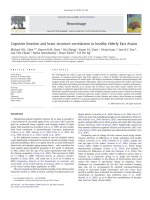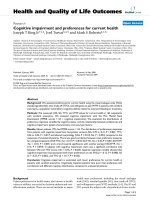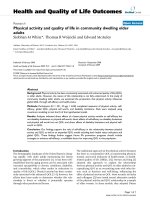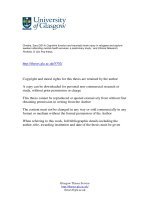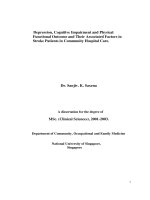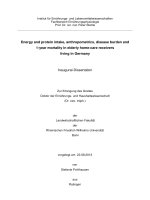Depression, cognitive impairment and physical functional outcome and their associated factors in stroke patients in community hospital care
Bạn đang xem bản rút gọn của tài liệu. Xem và tải ngay bản đầy đủ của tài liệu tại đây (251.27 KB, 107 trang )
Depression, Cognitive Impairment and Physical
Functional Outcome and Their Associated Factors in
Stroke Patients in Community Hospital Care.
Dr. Sanjiv. K. Saxena
A dissertation for the degree of
MSc. (Clinical Sciences), 2001-2003.
Department of Community, Occupational and Family Medicine
National University of Singapore,
Singapore
1
Contents:
A. Acknowledgements
6.
B. Abstract
7-8.
C. Background and Literature Review
9-30
1. Definition, types and causes of stroke
10-11
2. Global scenario of stroke
11-13
3. Overview of stroke in Singapore
13-15
4. Functional recovery in stroke patients
16-19
5. Dementia and cognitive impairment in stroke patients
19-23
6. Depression in stroke patients
23-27
7. Other outcomes in stroke patients
28-30
8. Summary of the literature review
30
D. Aims of the study
31
E. Methods and materials
32-41
1. Study---design, setting, period and population
33
2. Methods
34-36
3. Clinical definitions and measurements
37-39
4. Data analysis
39-41
F. Results
1. Description of the study population
42-73
44-49
1.1 Socio-demographic variables
44
1.2 Clinical variables
46
2
1.3 Neurological variables
48
2. Discharge destinations
50
3. Post stroke depression
51-62
3.1 Prevalence of depression
51-52
3.2 Univariate analysis of the factors associated
with post stroke depression
55
3.3 Multivariate Analysis of the factors associated
with post stroke depression
58
3.4 Univariate analysis of the factors associated
with recovery from post stroke depression
59
3.5 Multivariate analysis of the factors associated
with recovery from post stroke depression
62
4. Post stroke cognitive impairment
63-67
4.1 Prevalence of cognitive impairment
63
4.2 Univariate analysis of the factors associated
with cognitive impairment in stroke patients
63
4.3 Multivariate analysis of the factors associated
with cognitive impairment in stroke patients
67
5. Functional recovery during hospitalization
68-73
5.1 Prevalence of functional status
68
5.2 Univariate analysis of the factors associated
with ADL dependency on discharge
70
5.3 Multivariate analysis of the factors associated
with ADL dependency on discharge
73
3
G. Discussion and conclusions
74-82
1. Discussion
75-81
2. Limitations of the study
81-82
3. Conclusions
82
E. References
83-95
F. List of tables and figures
A. Figures:
1 Discharge destinations of the patients
2 Functional status on admission and on discharge
B. Tables:
1 Frequencies of socio-demographic variables
50
69
45
2 Frequencies of clinical variables
47
3. Frequencies of neurological variables
49
4. Univariate analysis of the factors associated
with post stroke depression on admission
56-57
5. Multiple Logistic regression analysis of depression
in stroke patients on admission
58
6. Univariate analysis of the factors associated
with recovery from depression.
59-61
7. Multiple logistic regression of analysis of
recovery from depression
62
8. Univariate analysis of the factors associated
with cognitive impairment on admission
64-66
9. Multiple logistic regression analysis of
cognitive impairment on admission
67
10. Univariate analysis of factors associated
with ADL dependency on planned discharges
71-72.
4
11. Multiple logistic regression analysis of
ADL dependency on planned discharges
G. Appendices
73
96-107
1. Patient protocol sheet
96-100
2. N.I.H.S. Scale
101-103
3. Barthel Index
104-105
4. Abbreviated Mental Test
106
5. Geriatric Depression Scale (Short Form)
107
5
Acknowledgements:
I would like to express my sincere thanks and gratitude to my supervisor,
Dr. Fong Ngan Phoon for his support and advice in conducting the research study
and in the preparation of the dissertation.
My heart felt gratitude and thanks to my co- supervisor, A/ Prof. Ng Tze Pin for
his patience, support, guidance and advise through out the research study and in
the preparation of the dissertation.
My special thanks to:
•
Dr. David Yong for providing the hospital setting of Ang Mo Kio
Community Hospital to conduct the research study.
•
Madam Png Hee Huay for assisting me very patiently in the research study.
Last but not the least, my loving gratitude to my parents and family members for
their constant encouragement and support during the entire period of my stay in
Singapore for this course.
6
Abstract:
Depression, Cognitive Impairment and Physical Functional Outcome and
Their Associated Factors in Stroke Patients in Community Hospital Care.
Aims: There have been inconsistent reports about the relationships between
factors associated with clinical and psychosocial outcomes of stroke in previous
research studies. The aim of this research study is to examine the relationship
between depression, cognitive function and physical functional outcome and their
associated factors in stroke patients in two community hospitals in Singapore,
where the step down post acute care is given to the patients.
Methodology: An Observational Cohort Study on 200 stroke patients in two
community hospitals was conducted. The patients were examined after seeking
their informed verbal consent upon their admissions and upon their planned
discharges, using Barthel Index for ADL dependency, Geriatric Depression Scale,
Abbreviated Mental Test and the NIHS Scale for Neurological Impairment.
Results: On admission, 120 (60%) patients were depressed, 107 (54.5%) were
cognitively impaired and 53.5 % of the patients had severe functional impairment
(Barthel Index < = 50). Among the patients with planned discharges, 34 patients
had ADL dependency (Barthel Index < = 50) upon discharge. Significant
independent predictors of depression were severe neurological impairment
(OR=3.29, CI=1.09; 9.03), cognitive impairment (OR=3.57, 95%CI =1.82; 7.03
and multifocal lesion (O.R. =1.98, 95% C.I. = 1.02; 3.84).
7
Significant independent predictors of post stroke cognitive impairment were age
more than 81 years (O.R. =6.78, 95% C.I. = 2.34; 19.64), less than secondary
level education (O.R = 4.73, 95% C.I. = 1.41, 13.11), severe neurological
impairment (O.R. = 5.00, 95% C.I. = 1.70, 14.67) and depression
(O.R. = 3.19, 95% C.I. = 1.61, 6.30). Significant independent predictors of ADL
dependency were cognitive impairment (OR= 6.85, 95%CI=1.82, 24.90), severe
neurological impairment (OR=5.18 95%CI=1.07, 25.08) , post stroke dysphagia
(O.R. = 3.82, 95% C.I. = 1.28, 11.38), severe functional impairment on admission
(O.R.=18.58, 95%C.I. = 2.13, 161.94)
Conclusion: Significant number of stroke patients are depressed and cognitively
impaired during hospitalization, which are, significant factors associated with
ADL dependency in stroke patients.
8
Background
And
Literature Review
9
Definition:
Stroke, according to W.H.O. definition is, “a syndrome of rapidly developing
clinical signs of focal or global disturbance of cerebral function, with symptoms
lasting 24 hours or longer or leading to death, with no apparent cause other than of
vascular origin”. This includes subarachnoid hemorrhage but excludes transient
Ischemic attack (TIA), subdural haematoma and hemorrhage or infarction caused
by infection or tumor.1
Categories of cerebrovascular accident (C.V.A.) include ischemia-infarction
and intracranial hemorrhage.2
Cerebral ischemia is caused by a reduction in blood flow that lasts for several
seconds to a few minutes. The neurological symptoms are manifested within 10
seconds because neurons lack glycogen and suffer rapid energy failure.2 Cerebral
hemorrhage produces neurological symptoms by producing a mass effect
on neural structures or from the toxic effects of blood itself.2
Frequency and important causes of ischemic & hemorrhagic Stroke 2
Stroke Subtype:
Frequency(%)
Important Causes:
Ischemic
85%
Atherosclerosis of intracranial arteries
Thrombotic / Embolic
Atrial Fibrillation; Mural Thrombus;
Myocardial infarction.
10
Stroke Subtype:
Frequency(%)
Important Causes:
Hemorrhagic
15 %
Hypertension; Arteriovenous
Intraparenchymal /
malformation.
Subarachnoid
Ruptured aneurysm.
Global Scenario of Stroke:
Stroke is one of the major global health concerns. Worldwide stroke is the second
most common cause of death after ischemic heart disease.3 It leaves behind 4.38
million people dead and 9 million stroke survivors in a year with two third of the
stroke deaths occurring in non-industrialized countries.1, 3 Hence among the noncommunicable diseases stroke has one of the highest mortality rates.
Overall in the world Cerebrovascular disease has been projected to be the
fourth most common cause of disability adjusted life years (DALY) by 2020 after
ischemic heart disease, unipolar depression and road traffic accidents.4 DALY
was developed to assess the global burden of disease. It is calculated as the sum of
years of life lost and years of life lived with disability. 3
The overall incidence rate of stroke is around 2-2.25 per thousand population
and a total prevalence rate is around 5 per thousand population.1 It has been
estimated that one in four men and nearly one in five women aged 45 years can
expect to have stroke if they live to their 85 th year.1
11
Although the life time risk of having an acute stroke is higher in men than
women, the converse is true for the life time risk of dying of a stroke.1 Double the
number of females (about 16%) are likely to die as compared to males (about 8%)
and this has largely been attributed to the higher mean age at stroke onset in
women.1
Stroke is one of the most disabling diseases being the leading neurological
cause of disability in the elderly in industrialized countries. 5 More than half of
the survivors of severe stroke remain severely disabled 6 and after completed
rehabilitation in Stroke units, only a third of those who survive are discharged
back to their own homes to a somewhat independent life, with no or only mild or
moderate disability.7 One year after stroke onset, only 65% of the patients are
functionally independent.1
Stroke also has a great economic impact. It has been estimated that the cost
of stroke in U.S. is 30 billion dollars annually. Out of this 30 billion dollars, 17
billion dollars is the direct cost i.e. total hospital, physician, rehabilitation and
equipment charges and 13 billion dollars is the indirect cost in terms of lost
productivity.8 Total cost of acute hospitalization accounts for only 20% of the
total direct and indirect costing of stroke8
Stroke not only causes significant physical health and economic burden
world over but also has psychosocial effects, which directly or indirectly affects
12
the recovery.
Depression has been reported as the most probable frequent emotional
disorder that occurs after stroke. 9.The prevalence of post stroke depression
varies from 20-65% 9, 10. Inspite of such a high prevalence of post stroke
depression, it is commonly unrecognized and untreated in clinical practice. 10.
Overview of Stroke in Singapore:
Stroke has been the third leading cause of death in Singapore after ischemic heart
disease and cancer since 1970 and comprises 10-12% of all deaths, 11,14 though it
slipped to fourth position in 1995 after pneumonia.14
Age and sex standardized death rate of stroke patients in Singapore has seen
a downward trend and this has mainly been attributed to decrease in risk factors
for stroke in the local population.11 There are also ethnic differences in stroke
mortality rates in Singapore with Malays having the higher rate as compared to
Chinese and Indians.12
Substantial numbers of stroke patients have been found to be functionally
dependent after hospital discharges. N P Fong et al 17 in their three month
prospective study on stroke patients in Singapore found that 63.3% of the stroke
patients were still moderately or severely impaired.
13
Similarly substantial numbers of stroke patients have also been found to be
depressed during their rehabilitation. Chan Keen et al 18 in their prospective study
in Singapore found that the percentage of stroke patients who were depressed on
admissions and upon their discharges from the hospital was 55 % and 28.6%
respectively. They had diagnosed depression in their study subjects using
Hamilton depression scale and psychiatric examination using
DSM-III revised criteria.
Likewise significant number of elderly patients are demented. Kua et al 19 in their
study found the overall prevalence of dementia to be 1.8%. They also found that
this rate increased to 4.8% for those who were 80-84 years of age and 12% for
those who were 85 years and more. Hsein et al 20 in their study on elderly Chinese
population found the prevalence of cognitive impairment to be 7.7% when
diagnosed by the assessment tool ECAQ and 13.2% when IQCODE was used as an
assessment tool.
In Singapore the mean cost per discharge for acute stroke patients has
been reported to be 7,547 Singapore dollars with a range of 320-68,614 Singapore
dollars. The break up of this expenditure has been reported as 38.2% of the
charges as ward fee, 14.5% as radiology fee, 10.3% as doctor’s fee, drugs and
therapy making 8.4% and 7.3% of the total charges respectively.13 The mean
length of stay in acute care hospital is 17 days.13 The cost of hospital care has
been reported to be highly co-related to length of hospital stay.13
14
The graying population (more than equal to 65 years) in Singapore is
constantly increasing. It has increased from 3.3% to 4.9% to 6.6% of the total
population since 1970 to 1980 to1990.11,16 and is expected to be 20.0 % of the
total population by 203016. An important factor responsible for the graying of the
population is the ageing of the baby boomers (the cohort born between
1945 – 1955) 16
Since ageing is an unmodifiable risk factor for stroke 14, 15 hence with the
expected increase in the ageing population in Singapore, the number of hospital
admissions, mortality and morbidity from stroke is expected to increase.
15
Outcomes of Stroke:
(1) Functional recovery:
Henrik et al21 in their research study on 223 patients found that patients with most
severe stroke who achieve a good functional outcome (Barthel index > = 50) are
generally characterized by younger age, the presence of a spouse at home, and
early neurological recovery. They did not find comorbid conditions to be
significantly related to functional recovery.
Meins et al 22 found in their prospective study on 302 patients that
independence in ADL as assessed by Barthel index > = 85, 24 months after
discharge, was 43.2% and it’s significant predictors were barthel index > = 50 on
admission, urinary continence and absence of coronary artery disease.
They also found that good functional outcome as assessed by Modified Rankin
Score of < = 3, 24 months after discharge, was 38.4% and it’s significant
predictors were urinary continence, absence of coronary artery disease, admission
barthel index score of > = 50, mild motor paresis and good sitting balance.
K C Johnston et al 23 in their research study on 256 patients found that the
increasing age, severity of stroke at onset and prior disability are significant
predictors of poor outcome as assessed by barthel index < 60 or death.
Maurizio et al 24 in their prospective study on 3628 patients found that impaired
consciousness on admission, limb weakness, progressive worsening of infarct,
16
ischemic heart disease, cardiac arrythmias were significant predictors of severe
disability on discharge. In their study they did not find age to be an independent
predictor of poor outcome but found hypercholesterolemia to be related
significantly to a better outcome.
Margaret et al 25 in their research study on 3760 patients from 96 rehabilitation
facilities constructed a predictive index using logistic regression to achieve the
following, viz. eating, grooming, and dressing the upper body, continence in
bladder and bowel and transfer between a bed and chair with supervision only.
They found that this stage was achieved by 26.1% of the patients functioning
below it at rehabilitation admission. Significant factors in the predictive index
were disability onset of less than 60 days, living alone, employed before stroke.
They also found that 95.3% of the patients who achieved this were discharged
home as opposed to only 66.8% of those who did not achieve this.
Peter Appelros et al 26 in their prospective study on 377 subjects found that 1 year
mortality was 33%. After 1 year , 37% of the survivors were dependent and 9% of
the survivors had a recurrent stroke within a year. In their study they found that
dependency was associated with age, stroke severity and heart failure.
H. Henn et al 27 in their prospective study on 152 patients found that dependency
(score of 3-5 on Glasgow outcome scale) at 3 months was related to severity of
clinical deficit at stroke onset, previous stroke and increasing age.
17
Likewise Marco et al 28 in their prospective study found that increasing age and
clinical deficit at stroke onset predicted the poor outcome (as assessed by death or
score of > = 3 on Rankin scale) at 4 months following stroke.
N.A. taub et al 29 in their prospective study found that at 3 months after stroke
onset 9% were severely disabled, 15% were moderately disabled and at 12 months
11% had moderate or severe disability for which initial incontinence was a
significant predictor.
Stefano et al 30 in their 1 year prospective study 172 patients found that 43.3% of
the patients maintained the level of functional ability which they achieved during
inpatient rehabilitation treatment, 23.6% improved and the remaining 23.6%
worsened. They found that the patients more than 65 years of age and with
hemineglect had a higher probability of worsening. They also found that post
discharge rehabilitation (performed by 46.5% of the final sample) was
significantly and positively associated with functional improvement and it’s
absence was associated with functional worsening.
Henrik et al 31 in their prospective study on 1000 patients found that stroke type
had no influence on mortality, neurological outcome, functional outcome or the
time course recovery. They found that severe stroke at onset had an adverse
prognostic value on the stroke outcome.
18
M.R. Frankel et al 32 in their study found that co morbidities like diabetes mellitus,
hypertension, and ischemic heart disease and type of stroke do not predict the
functional outcome in stroke patients though Maurizio et al 24 in their prospective
study on 3628 patients found ischemic heart disease and cardiac arrhythmias as
significant predictors of severe disability at discharge. They also found that
impaired consciousness on admission, limb weakness, progressive worsening
were also predictors of severe disability on discharge.
(2) Post stroke dementia & Cognitive impairment:
In different research studies varying percentages of post stroke dementia &
cognitive impairment have been reported.
T. Pohjasvaara et al 33 in their study on 337 patients between 55-85 years of age at
three months after stroke found that 31.8% of the patients had post stroke
dementia (107/337); 28.4% had stroke related dementia (Alzheimer’s disease plus
vascular dementia excluded); and 28.9% had dementia after first ever stroke. For
the diagnosis of dementia they had done the clinical examination of the patients
using DSM-III criteria They also found a significant relationship between
dementia and dysphasia, major dominant stroke syndrome, history of previous
cerebrovascular disease and low educational level.
Raquel et al 34 in their prospective study on 251 patients found that 75 (30%)
patients were demented at three months follow up. 25 patients had dementia
before the stroke onset. They had assessed dementia in the patients on the basis of
19
clinical examination using DSM-IV criteria. In their research study they found
that the significant correlates of dementia were increasing age, previous
nephropathy, atrial fibrillation, severe neurological impairment & previous mental
decline.
Domenco et al 35 in their prospective study at stroke onset and one year after
stroke onset found that 57 (16.8%) of the patients had post stroke dementia. They
had used a proxy-informant interview based on ICD-10 criteria for diagnosing
dementia.. They found that post stroke dementia was significantly related to atrial
fibrillation, aphasia & severity of stroke at onset.
David et al 36 in their prospective study on 453 patients found that mortality rate
was 15.90 deaths /100 person years among the demented patients against 5.37
deaths / 100 person years among the non-demented group. They also found that
dementia is a significant predictor for decreased survival even after adjusting for
other known predictors of mortality. They had diagnosed dementia in patients
using modified DSM-III revised criteria.
H. Henon et al 37 in their prospective study on 202 subjects found that independent
predictors of post stroke dementia are aging, pre-existing cognitive decline,
severity of deficit on admission, diabetes mellitus and silent infarcts.
David et al 38 in their cross sectional study found that the crude incidence rate of
20
dementia was 8.49 cases/ 100 person years in stroke patients and 1.37 cases per
100 person years in control. They also concluded that cerebral hypo- perfusion is
the basis for some cases of dementia after stroke.
D.W. Desmond et al 39 in their research study on 453 patients at three months after
stroke found that 119/453 (26.3%) of the stroke patients were demented and the
significant predictors of dementia were location of lesion, severity of the
presenting stroke, diabetes mellitus, previous stroke, old age, low education and
non-white ethnicity. They had diagnosed dementia using DSM-III revised
edition criteria.
L. Zhu et al 40 in their 3 year prospective study on 1551 subjects of more than 75
years of age with no sign or history of stroke found that the incidence of stroke
was 26.8 per 1000 person years. Subjects with mild dementia had a relative risk of
2.6 of developing stroke after controlling for the confounding factors. They also
found out that the subjects with cognitive impairment had a relative risk of 2.0 of
developing stroke. Hence mild dementia and cognitive impairment are associated
with an increased incidence of stroke among the subjects more than equal to 75
years of age. They had assessed patients for dementia using revised DSM-III
criteria and had assessed them for cognitive decline using MMSE scale.
Li Zhu et al 41 in their cross sectional study found that the stroke patients were 3
times more demented than those without stroke (O.R.= 3.6) and that stroke was
21
also significantly associated with cognitive impairment without
dementia (O.R.= 2.4). In their research study they also concluded that the
population attributable risks of dementia and cognitive impairment in relation to
stroke were 18.4% and 8.5% respectively. They had assessed patients for
dementia using revised DSM-III criteria and cognitive assessment was done using
MMSE scale.
Steffano et al 42 in their prospective study on 273 study subjects found that
cognitive impairment is a significant predictor of poor functional outcome in
stroke survivors even after adjusting for age and severity of stroke. For cognitive
assessment they had done neuropsychological examination to detect the presence
of hemispatial neglect and language disorders in the patients.
Likewise Tarja et al 43 in their research study on 486 patients at 3 months after
stroke found that cognitive impairment has an important functional consequence
on the stroke patients. Cognitive assessment was done using MMSE scale.
T. Pohjasvaara et al 44 in their prospective study at 3 and 15 months on 486
patients found that worsening in cognition and worsening of depression between 3
and 15 months follow up had an independent effect on the dependent living 15
months after ischemic stroke. Cognitive assessment was done using MMSE scale.
Mahito et al 45 in analyzing data from a double blind trial found that the depressed
22
patients whose depression remitted had significant recovery in cognitive function
as compared to the patients whose mood did not remit. They had assessed the
change in cognition using MMSE scale.
R.M. Parekh et al 46 in their prospective study on 103 patients did not find a
significant correlation between depression and cognitive impairment. Whereas
R.G. Robinson et al 47 in their prospective study on 103 patients found a
significant relationship between depression and cognitive impairment.
C.S. Kase et al 48 in their prospective study on 74 patients found that there was a
significant decline in the cognitive function when the pre and post stroke
cognitive performance was measured. They also found that the depression was
frequent in stroke patients but the intellectual decline in stroke patients is
independent from presence of depression.
(3) Post stroke depression:
Depression has been reported to be the most probable frequent emotional
disorder occurring after stroke.9 The reported frequency of post stroke depression
in different studies ranges from 20- 65%. This wide variation of post stroke
depression is due to different criteria for patient selection and study done over a
different time period following stroke.9
Post stroke depression goes commonly unrecognized and untreated in clinical
practice.10
23
Eran et al 9 in their prospective study found that the patients whose mood
improved had a greater recovery in ADL than the patients whose mood did not
improve. They had diagnosed depression in the patients on the basis of a
structured psychiatric examination and DSM-1V diagnostic criteria.
Tarja et al 10 studied a consecutive series of 486 patients with ischemic stroke aged
from 55 to 85 years. Of these, 277 patients underwent a comprehensive psychiatric
evaluation, including the Present State Examination, from 3 to 4 months after
ischemic stroke. The criteria of the Diagnostic and Statistical Manual of Mental
Disorders, (DSM-III -R) were used for the diagnosis of depressive disorders.
They found that the frequency of any depressive disorder was 40.1% (n=111).
Major depression was diagnosed in 26.0% (n=72) and minor depression in 14.1%
(n=39). Major depression with no other explanatory factor besides stroke was
diagnosed in 18.0% (n=49) of the patients. Comparing depressed and non
depressed patients , they found no statistically significant difference in sex, age,
education, stroke type, stroke localization, stroke syndrome, history of previous
cerebrovascular disease, or frequency of DSM-III-R dementia. According to the
multiple logistic regression model, dependency in daily life correlated with the
diagnosis of depression and with the diagnosis of major depression A history of
previous depressive episodes also correlated with the diagnosis of depression and
with the diagnosis of major depression, whereas solely stroke-related major
depression correlated with stroke severity as measured on the Scandinavian Stroke
Scale .
24
Mervi et al 49 in their prospective study on 594 patients found that age and
neurological impairment were significant predictors of depression. They also
found that among the depressed stroke patients who were given some therapy
(extra rehabilitation and social encouragement), 41% of the patients with active
programs were depressed as compared to 54% in the control group. They had used
Beck`s Depression Inventory (B.D.I.) for diagnosing depression.
In a 3 month and 1 year prospective study on 150 patients N. Herrmann et al 50
found that depressed stroke patients were more females, more neurologically
impaired and had more previous history of depression as compared to nondepressed patients. In their study they also found out that depression was not corelated to age, side of lesion or lesion volume. They also found that at three
months marked depressive symptoms were 22% to 27% and 21% to 22% at 1
year by Zung self Rating scale and Montgomery Asberg Depression Rating
Scale respectively.
Stefano et al 51 in their case control study on 290 patients found that depressed
patients despite of having the same neurological impairment as non-depressed
patients, were more ADL disabled on admission and on discharge.They also found
that both the depressed and non-depressed stroke patients made the same average
functional recovery but the non-depressed patients were twice as likely to show
excellent recovery on ADL as compared to the non-depressed group. They had
assessed patients for depression using Hamilton depression scale and clinical
25
